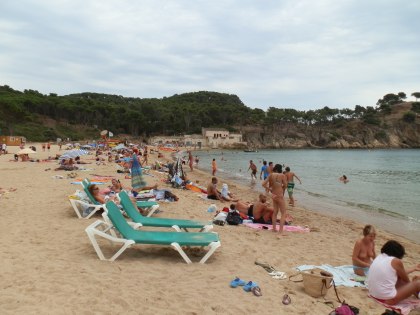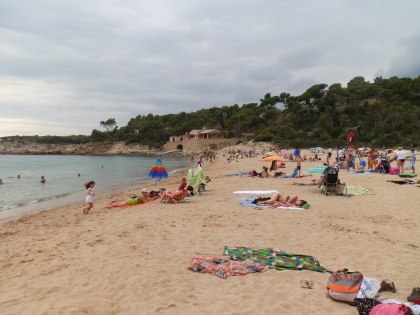Beach at Platja de Castell - swimming and canoeing
 Platja de Castell is a very large unspoilt sandy beach situated just to the north of Palamos La Fosca. It's unusual in that for such a large beach it is actually in a protected area so there is no development allowed. It also marks the start of the set of wild beaches and bays that run up to Cap Roig and Calella de Palafrugell and as a result it is very popular as a starting point for canoeing up the coast.
Platja de Castell is a very large unspoilt sandy beach situated just to the north of Palamos La Fosca. It's unusual in that for such a large beach it is actually in a protected area so there is no development allowed. It also marks the start of the set of wild beaches and bays that run up to Cap Roig and Calella de Palafrugell and as a result it is very popular as a starting point for canoeing up the coast.
The beach itself sits underneath an Iberic village on the cliffs to the left and has two older houses at either end but otherwise is completely natural. The woods and paths to the north lead to other secluded bays and beaches and in the forest you can find an artist studio/hut built specially for Salvador Dali. The beach has been used for filming and appears in a number of Spanish films.
The area to the right side, immediately below the pink house, and behind the last set of rocks is often used by naturists. Generally they can't be seen unless you specifically climb the rocks or swim over to the bay in that direction.
Facilities at the beaches
Though the beach is unspoilt, it does benefit from chiringuitos (beach-bars) on the beach, temporary toilets and a canoe hire service (to the left). Normally in the height of summer there are yachts and motor boats anchored in the bay outside the swimming line. At the back of the beach is an informal picnic area under the trees and a large seasonal car park is created every summer in the fields at the back with access from the C-31 dual carriageway. Parking is €5 per day until about 17.00 in the afternoon.
The Benelux Campsite is located about 1km away on the beach access road close by to Hotel Malcontent five-star hotel. The beach is connected to the Ruta del Tren Petit cycle paths and there is a lot of cycling and walking nearby.
Sand quality
The sand is soft and good quality in the main, but storms this year (2015) mean that entering the water now has pebbles and shingle for the right hand side of the beach. The left side closer to the cliffs of the Iberic village is softer.
 Swimming
Swimming
The bay is broad and quite open and one day can be smooth as a millpond, then the next have metre high waves. If the wind is blowing or the waves are coming, then the area under the cliffs to the left hand side tends to be quite sheltered and calm even on rough days. This is also the area best for snorkeling, seeing fish and exploring with a small sea cave under the cliffs.
The left hand side also shelves most gently into the water. Having said that, the main beach areas also has a quite gentle shelving and it's popular with families.
For long distance swims across the bay is fine, though there can be a chop from the sea-ward side. Alternatively swimming out close to the cliffs on the left will also give a good swimming distance. On the right, there are also rocks and snorkelling with the next bay of Cala S'Alguer around the headland (not swum this).
Canoeing
Castell is an excellent option for canoeing and kayaks can be hired on the beach or brought through to the beach from the car park (it's a long carry though). Even if you do it for a short time, there is a lot to explore. In particular, immediately around the corner of the left hand cliff under the Iberic village is a hidden bay only accessible by boat with sea-caves and tunnels you can paddle through.
Further on are the bays of Cala de Senia and Cala Estreta which are more isolated wild beaches with sandy beaches and rocky bays, but excellent for seeing fish. We've kayaked all the way from Castell to Llafranc taking about 2.5 hours one way including a stop in El Crit. It could be done more slowly exploring more of the caves and islets. Outside the shelter of the bays, if the wind is blowing, the sea can be choppy and in some of the quieter bays you will have to look out for rocks beneath you, but it's a marvellous way to explore the coast as many parts of the Castell-Cap Roig natural area are only accessible from sea.
To the right, an easy canoe is towards La Fosca through the bay of Cala s'Alguer a very pretty, and much photographed, run of fishermen's houses on a pebbly beach with a bay dotted with rocky islets.
Parking
Parking is easy with a temporary seasonal car park at the back of the beach which costs €5 per day.
Walks
This is one of the best areas for walking with the GR92 through the protected area of Castell-Cap Roig and the wild beaches of this area, or following the headland path to La Fosca.
For walks see: Calella de Palafrugell/Cap Roig to Castell - classic wild Costa Brava - Platja de Castell and La Fosca
For cycling see: Eulogy to the Ruta del Tren Petit (Palafrugell, Palamos, Mont-ras and Vall-llobrega)
Next beaches
South to La Fosca, Palamos - North to Cala Estreta and wild beaches to El Crit and Cap Roig

 Walks and other things
Walks and other things